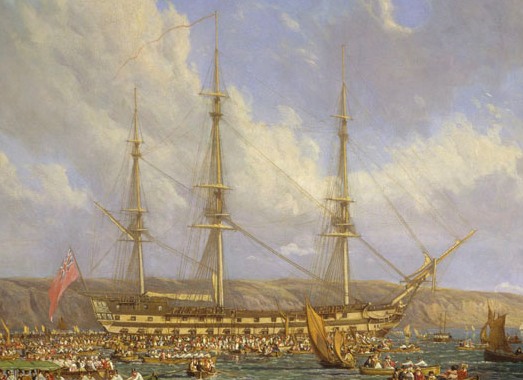 |
| HMS Bellerophon, a 75-gun ship similar to the Ramilles, which was repeatedly targeted by American IEDs during the War of 1812. Nickname: "Billy Ruffian." |
The United States and its patriotic citizens, set upon by the vast forces of the British Royal Navy in the War of 1812, came up with many "infernal devices" to even the playing field. These improvised explosive devices seem--eerily-- to echo the tactics of asymmetrical warfare faced by US troops abroad today...
The British navy had a total of 1017 vessels--258 ships-of-the-line, 240 frigates, 64 sloops of war, 12 bomb and fire ships, 191 brigs, 42 cutters, and 65 schooners and luggers...In March, 1813, Congress passed a law allowing the payment of the value of any English vessel blown up or destroyed in any manner by persons not in the actual service of the United States. Thus the whole British blockading squadron on our coast was a subject for private enterprise. The game was too big and tempting to let go without many efforts.
The torpedoes in use were those invented by Robert Fulton for blowing up ships...These torpedoes consisted of a copper case which contained from fifty to one hundred pounds or more of powder. To this was fixed a gun-flint lock in a brass box, water tight, which lock could strike fire by several means. One was by clockwork [my italics], which could be set to one or more minutes or hours for striking the fire. Another was for being sunk at a given depth under water and a float, to which was attached a lever or catch near the surface of the water, which when hit by anything would spring the lock and strike fire. Another was by hitching one or more torpedoes to the middle of a rope a hundred feet or more long, and having a row boat at each end drag the torpedoes to an enemy's vessel or under it and either spring the gun-lock by clockwork or by contact with the vessel, and thus blow her up. (from R.S. Guernsey, New York City and Vicinity During the War of 1812-15, New York, 1889.)
Although Fulton's mines had been demonstrated to effectively blow up a test schooner, they were never actually used against a British ship that we know of. However, another enterprising man used a variation on the classic "fireship" ploy that sounds like something a movie villain would do:
A schooner, called the Eagle, was fitted out by John Scudder, Jr... He placed ten kegs of powder, about 400 pounds, with a quantity of sulphur mixed with it, in a strong cask, and surrounded it with huge stones and other missiles... At the head of the cask, in the inside, were fixed two gun-locks, with cords fastened to their triggers at one end, and two barrels of flour at the other end, so that when the flour should be removed, the locks would be sprung, the powder ignited, and the terrible mine exploded.
As expected, the schooner was captured in Long Island Sound by the British warship
Ramilles. The crew escaped to Millstone Point and sat back to watch the fireworks...
...Boats were sent out for the cargo. The hatches of the Eagle were opened, and when the first barrel of flour was removed, the explosion took place. A column of fire shot up into the air (the inventor of it said it reached up nine hundred feet) and a shower of pitch and tar fell upon the deck of the Ramilles. The Eagle, a British officer, and ten men, were blown to atoms, and most of the boats outside were seriously or fatally injured.
Ramilles escaped, and although for a while the local British commodore was threatening to destroy "everything American that floats" in retaliation for what was basically a terrorist attack, things returned to normal on the blockaded shoreline--that is, until an even weirder inventor took another shot at
Ramilles:
A citizen of Norwich invented a submarine boat in which he could voyage three miles an hour. In this he went under the Ramilles, which was frequently seen near New York, and had nearly completed his task of fixing a torpedo to her bottom when his drill broke, he was discovered and his effort was foiled, but he escaped.
The enraged and fearful British navy landed a strong force where the submarine had beached, and blew it up to prevent any more attempts. The Commodore announced that American prisoners would be kept aboard British vessels, and ordered that the Ramilles be kept in motion and "caused her bottom to be swept with a cable every two hours, night and day, to keep off the 'damned Yankee barnacles'"!
 |
| A torpedo (sea mine) from the 1860s. |
 |
| A critical improvement in detonators: a device to trigger mines electrically from the American Civil War. |
 |
| Fulton's mines probably looked more like these barrels, reconstructions of Confederate mines from the vicinity of Wilmington, N.C. |
As interesting as these early sea mines were, they failed to destroy any British ships. It would take until the American Civil War for anti-ship weapons like the electrically detonated mine and the submersible for these new weapons to begin to make an impact on naval warfare.




No comments:
Post a Comment
Note: Only a member of this blog may post a comment.